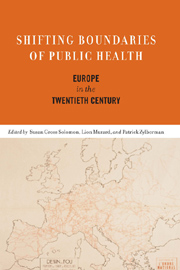Book contents
- Frontmatter
- Contents
- Preface
- Introduction
- Part One Place as Politics
- Part Two Carving Out the International
- Part Three Preserving the Local
- Part Four Navigating between International and Local
- 9 A Matter of “Reach”: Fact-Finding in Public Health in the Wake of World War I
- 10 A Transatlantic Dispute: The Etiology of Malaria and the Redesign of the Mediterranean Landscape
- Selected Bibliography
- List of Contributors
- Index
10 - A Transatlantic Dispute: The Etiology of Malaria and the Redesign of the Mediterranean Landscape
from Part Four - Navigating between International and Local
Published online by Cambridge University Press: 12 September 2012
- Frontmatter
- Contents
- Preface
- Introduction
- Part One Place as Politics
- Part Two Carving Out the International
- Part Three Preserving the Local
- Part Four Navigating between International and Local
- 9 A Matter of “Reach”: Fact-Finding in Public Health in the Wake of World War I
- 10 A Transatlantic Dispute: The Etiology of Malaria and the Redesign of the Mediterranean Landscape
- Selected Bibliography
- List of Contributors
- Index
Summary
On the threshold of the 1930s, malariology was already “a house divided.” In Europe, some researchers saw malaria as a “social disease” determined by socioeconomic factors (housing, food, poverty, working conditions). Others, particularly in America, believed it to be a “local disease” contingent on insect and human geography in the affected area. Debates over etiology were reflected in the solutions championed. For partisans of basic health care, the treatment of patients and their dwellings was the priority; for partisans of public health campaigns, the key lay in the struggle against that most important feature of the malarial locale, the mosquitoes. American malariology was profoundly different from social malariology of a European ilk. During the construction of the Panama Canal (1906–13), William Crawford Gorgas, a U.S. Army medical officer, put the struggle against mosquitoes at the center of his strategy. Although its cost was prohibitive and its method never duplicated, the campaign became the wellspring of malaria-eradication efforts in the American South run by the Communicable Disease Center (1946–52), and of programs in Sardinia (1947–51), Italy (1947), and Greece (1946–49) run by national governments with the help of the United Nations Relief and Rehabilitation Administration (UNRRA) and the Rockefeller Foundation. The eradication program conducted under the aegis of the World Health Organization (1956–69) was likewise based on U.S. principles.
- Type
- Chapter
- Information
- Shifting Boundaries of Public HealthEurope in the Twentieth Century, pp. 269 - 298Publisher: Boydell & BrewerPrint publication year: 2008



